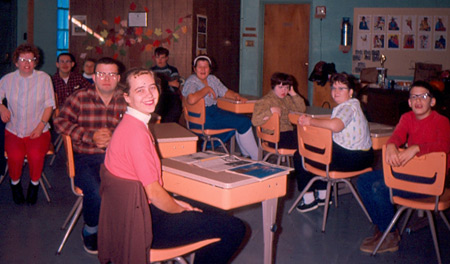Celebrating 60 Years of Growth and Success
In 1959, individuals with disabilities were rarely awarded the same opportunities as those without disabilities. That year, the local Pilot Club invited parents of children with disabilities to a meeting to discuss a class tailored to fit the needs of their children. On March 12th of that same year, an organizational meeting was held and officers were elected. In the summer of 1959 the first class of seven children gathered for a six week session. That was the beginning of Abilities Plus.
Here is a look at our history as compiled by Jean German, a parent and volunteer who was instrumental in assisting the agency become what it is today:
The first name of the agency was the Organization for Retarded Citizens. It was also known as Pilot House. In 1975 the name was changed to the Association of Retarded Citizens of Henry and Stark Counties. In 1989 the name changed again to Abilities Plus, which was felt to be a more politically correct name for the agency.
The Pilot Club of Kewanee called a meeting in February of 1959 and invited parents who had children with disabilities. The meeting was held at the YMCA in Kewanee. This was the agency's first meeting. On March 12, 1959, an organizational meeting was held, and the following officers were elected at the meeting on April 9, 1959: Frank Reece - President, Merle Streitmatter - Vice President, Faith Steimle - Secretary, Kary Gruzeczka - Treasurer, and Ernest George - Publicity Chairman.
In the summer of 1959, a class was held for six weeks at the First Baptist Church in Kewanee. Seven children attended. A movie was made of the class and shown to PTA groups and churches.
On January 4, 1960, the first class was opened in the Craig Building of Wethersfield School District. Mrs. Richard Soderlund was the first teacher. The class was held from 8:30 to 10:30 a.m. each day. Eleven students came from Kewanee, Atkinson, Galva, and Neponset. In September 1962, Mrs. Elizabeth Zang was hired to teach the older students. At 11:00 a.m. three days a week, the YMCA bus took the children to the YMCA. They had crafts, a gym period, and swimming.
In March 1963, Robert Petersen was named the Executive Director. On June 10, 1963, a summer program was started at St. John's Episcopal Church. That same year the school expanded. The board voted to rent space on the first floor of the Larson Building at 312 N. Main Street. Rent was $200 a month.
On September 30, 1963, Mrs. Louise Harris was hired as the Workshop Director. The students made bows. The first Open House was held on November 24, 1963. Approximately 400 people attended.
In 1964, enrollment increased and students were coming from Geneseo and Hillsdale. A volunteer program started and was directed by Ruth Flemming. A representative from the State of Illinois Child and Family Services visited the school, and the school was licensed. In October, the board of directors took possession of the Pony Express Trail. They were responsible for keeping the markers along the trail.
In 1966, high schools were informed that they needed to begin offering classes to children with disabilities. That same year, the Pilot House moved to the Armory, which was rent free. In the fall of 1970, Mr. Dinsmore Wood was hired as a part-time Executive Director. Along with Mrs. Streitmatter, Mr. Wood applied and received the first state grants.
In June 1971, Mr. Charles Sledgister was hired as the first full time Executive Director. This is also the year the board voted to purchase the Babka Building at 107 E. Mill St. The agency stayed at Mill Street for nine years, when operations moved to 319 N. Main Street. Later, Early Intervention and the Residential Program would return to Mill Street. The Residential Program returned briefly to the 319 N. Main location until 2004, when all programs moved to the Carol Blake Center at 1100 North East Street.
In 1972, the 500 Club was organized. The idea was to get 500 people to donate $1 per month per year. The club had 166 members. During that time, the first van was also purchased.
In 1974, the agency experienced much growth, as funding was approved by the Kewanee United Fund. A truck was purchased, and lengthy discussion was held by the board about building a residential facility. A personnel handbook was also adopted, the accounting system was brought up to date, and William Weber was hired as the Executive Director.
In 1980, Abilities Plus moved to 319 N. Main Street. Developmental Training and Work Services programs occupied half of the building on the north side. Administrative offices were above the Senior Citizens Center for a year before moving into the south side of the Main Street location.
In the early 1980's, Abilities Plus owned land across from the current location of the Carol Blake Center at 1100 N. East Street. The intent was to build a new facility on the land, but the property was sold a few years later.
In 1982, The Abilities Plus Resale Shop was founded by volunteers Hazel Pettit, Maxine Marchese, Kathryn Feldman, and Ester DeSplinter.
In 2004, all programs moved to the current location at 1100 North East Street, Kewanee, Illinois. On October 27, 2008 the name of the building was changed to "The Carol Blake Center" to honor Carol Blake, who retired as Executive Director after 25 years. The agency saw significant growth in all areas during her tenure.
In 2010, eight Abilities Plus clients moved into a new, accessible group home at 808 E. 11th Street in Kewanee.

